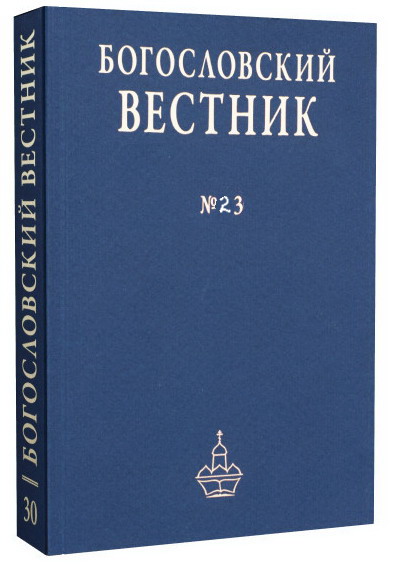“Assembled as One”: the origins and early meaning of the term “Monk” in the East according to the documents from II to IV c. A. D. Part II: Syriac sources
Keywords:
history of Christianity, history of the Church, Christian ascetics, ascetical theology, monasticism, emergence of monasticism, monastic life, theology of monastic life, bnay / bnat qyama, ihidaya, single ones, Aphrahat, Ephraim the Syrian, Syriac asceticism, Christian Syria, Christian Egypt, ascetic orders, monastic ordersAbstract
This article deals with the problem of identity and the origin of monasticism. To address this issue, the author applies a linguistic approach; he examines different contexts of the early use of the concept “Monk” according to Greek, Coptic and Syriac sources, in the dioceses of Egypt and Syria from the 2nd to the 4th century. A.D. The Greek term μοναχός and its Coptic transliteration nmonacos, as well as the Coptic term oua ouwt (“single one”), and the Syriac terms ihidaya and qyama are analyzed. Finally, the phenomenon described by the term “monk” in the early Christian milieu, did not come from nowhere; originally it was part of a wider ascetic movement of the early Church. This fact may modify the cherished notions regarding the origin of monasticism and its authentic identity. The phenomenon of monasticism in the Orthodox Church results from a long process of assimilation, unification and later interpretation of early Christian ascetic doctrines and experience during the Byzantine era.
Downloads
References
Кессель Г. Учение о духовной жизни Афраата Персидского Мудреца по «Тахвите о сынах завета» // БТ. 2003. Т. 38. С. 356-375.
Диодор (Ларионов), монах. Несколько замечаний о духовной и канонической ответственности рясофорных иноков // Церковный вестник. 21.09.2013. - Электронный ресурс: http://www.e-vestnik.ru/church/otvetstvennost_inokov_7324/ (дата обращения: 10.05.2016).
Пальмов Н. Пострижение в монашество. Чины пострижения в монашество в Греческой Церкви. Историко-археологическое исследование. К., 1914.
Adam A. Grundbegriffe des Mönchtums in sprachlicher Sicht // Zeitschrift für Kirchengeschichte. 1953-1954. Bd. 65. S. 220-231.
Baumschtark A. Geschichte der syrischen Literatur. Bonn, 1922.
Beck E. Ein Beitrag zur Terminologie des ältesten syrischen Mönchtums // Antonius Magnus Eremita 356-1956: Studia ad antiquum monachismum spectanta / Ed. B. Steidle. R., 1956 (Studia Anselmiana 38). S. 254-267.
Brock S. Clothing Metaphors as a Means of Theological Expression in Syriac Tradition // Typus, Symbol, Allegorie bei den östlichen Vätern und ihren Parallelen im Mittelalter. Internationales Kolloquium (Eichstätt, 1981) / Hrsg. M. Schmidt. Regensburg, 1982 (Eichstatter Beitrage 4). S. 11-40.
Brock S. The Luminous Eye: The Spiritual World Vision of St. Ephraem Kalamazoo, 1992 (Cistercian Studies 124).
Brock S. The robe of glory: A biblical image in the Syriac tradition // The Way. 1999. Vol. 39. P. 247-259.
Bumazhnov D. Zur Bedeutung der Targume bei der Herausbildung des ΜΟΝΑΧΟΣ-Konzeptes in den Nag Hammadi-Texten // Zeitschrift für Antikes Christentum. 2006. Bd. 10. S. 252-259.
Bumazhnov D. Einige Beobachtungen zur Geschichte des Begriffs ΜΟΝΑΧΟΣ // StP. 2006. Vol. 39. S. 293-299.
Bumazhnov D. Some Ecclesiological Patterns oft he Early Christian Period and Their Implications for the History of the Term ΜΟΝΑΧΟΣ (Monk) // Einheit der Kirche im Neuen Testament / Hrsg. A. A. Alexeev, Chr. Karakolis, U. Luz. Tübingen, 2008. S. 251-264.
Bumazhnov D. Some Further Observations Concerning the Early History of the Term ΜΟΝΑΧΟΣ (Monk) // StP. 2010. Vol. 45. P. 21-26.
Burkitt F. Ephraim’s Quotations from the Gospel. Cambridge, 1901 (Texts and Studies 7. 2). P. 6-19.
Chabot J. Littérature syriaque. P., 1934.
Cocchini F. Il Figlio Unigenito Sacrificato e Amato // Studi Storico-Religiose. 1977. Vol. 1. P. 201-323.
Van Esbroeck M. Peter the Iberian and Dionysius the Areopagite. Honigmann's thesis revisited // OCP. 1993. Vol. 59. P. 217-227.
Griffith 1989-1990 - Griffith S. Images of Ephraem: The Syrian Holy Man and his Church // Traditio. 1989-1990. Vol. 45. P. 7-33.
Griffith S. ‘Singles' in God's Service: Thought's on the Ihidaye from the Works of Aphrahat and Ephraem the Syrian // The Harp. 1991. Vol. 4. P. 145-159.
Griffith S. Monks, "Singles" and the Sons of Covenant. Reflections on Syriac Ascetic Terminology // ΕΥΛΟΓΗΜΑ. Studies in Honor of Robert Taft, SJ / Ed. E. Carr, S. Parenti, A.-A.Thiermeyer, E. Velkovska. R., 1993. P. 141-160 (Analecta Liturgica 17).
Griffith S. Asceticism in the Church of Syria: The Hermeneutics of Early Syrian Monasticism. Essays originally presented at an international conference on the Ascetic dimension in religious life and culture, held at Union Theological Seminary in New York / Ed. V. Wimbush, R. Valantis. New York, 1995.
Guillaumont A. Sémitismes dans les logia de Jésus retrouvés à Nag-Hamâdi // Jahrbuch für Antike und Christentum. 1958. Bd. 246. P. 113-123.
Guillaumont A. Le nom des ‘Agapètes // VCh. 1969. Vol. 23. P. 30-37.
Guillaumont A. Monachisme et étique judéo-chrétienne // Recherches de science religieuse. 1972. Vol. 60. P. 199-218.
Guillaumont A. Perspectives actuelles sur les origines du monachisme // The Frontiers of Human Knowledge / Ed. T. Segerstedt. Upsala, 1978. P. 111-123.
Kiraz G. The New Syriac Primer. Washington, 2013.
Morard F. Monachos, moine. Histoire du terme grec jusqu'au 4e siècle. Influences bibliques et gnostiques // Freiburger Zeitschrift für Theologie und Philosophie. 1973. Bd. 20. S. 332-411.
Morard F. Monachos: un importation sémitique en Egypte? Quelques aperçus nouveaux // StP. 1975. Vol. 12. P. 242-246.
Morard F. Encore quelques réflexions sur monachos // VCh. 1980. Vol. 34. P. 395-401.
Murray R. The Exhortation to Candidates for Ascetical Vows at Baptism in the Ancient Syriae Church // New Testament Studies. 1974-1975. Vol. 21. P. 59-80.
Murray R. Symbols of Church and Kingdom: A Study in Early Syriac Tradition. Cambridge, 1975.
Nagel P. Die Motivierung der Askese in der alten Kirche und der Ursprung des Mönchtums. B., 1966 (TU 95).
Nedungatt G. The Covenanters of the Early Syriac-Speaking Church // OCP. 1973. Vol. 39. P. 191-215, 419-444.
Παπαδόπουλος Σ. Μέγας Βασίλειος. Βίος καὶ θεολογία. Αθ., 1989.
Vööbus A. Celibacy: A Requirement for Admission to Baptism in the Early Syrian Church, Stockholm, 1951.
Vööbus A. History of Asceticism in the Syrian Orient. A Contribution to the History of Culture in the Near east. Louvain, 1958. Vol. 1: The Origin of Monasticism - Early Monasticism in Persia (CSCO 184).
Vööbus A. History of Asceticism in the Syrian Orient. A Contribution to the History of Culture in the Near east. Louvain, 1960. Vol. 2: Early monasticism in Mesopotamia and Syria (CSCO 197).
Wright W. Short History of Syriac Literature. L., 1894.
Аврелий Августин. Исповедь. М., 2003.
Афраат Персидский Мудрец. Тахвита о сынах завета / Пер. прот. Л. Грилихеса, Г. Кессель // БТ. 2003. T. 38. С. 120-146.
Василий Великий, свт. Творения в 2 т. М., 2009. Т. 2 (Полное собрание творений святых отцов Церкви и церковных писателей в русском переводе 4).
Downloads
Published
How to Cite
License

This work is licensed under a Creative Commons Attribution-NonCommercial 4.0 International License.








